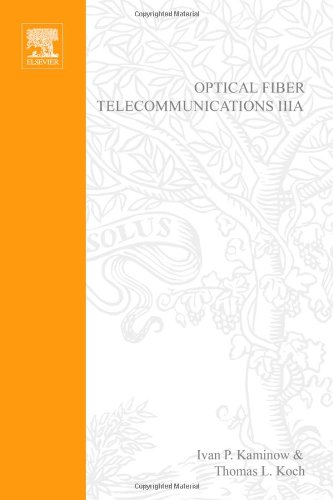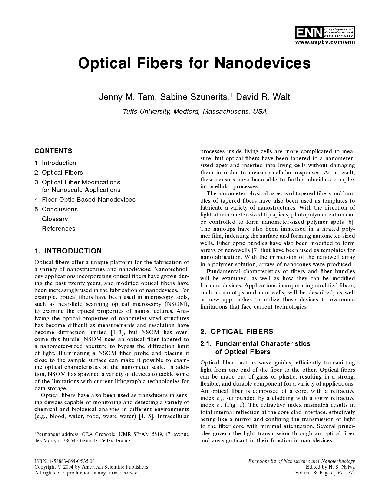Clifford Headley, Govind Agrawal9780120445066, 0120445069, 9781417577354
Table of contents :
Team DDU……Page 1
Table Of Content……Page 6
Contributors……Page 10
Preface……Page 12
1 Introduction……Page 16
1.1 Optical Fibers……Page 17
1.2 Raman Amplification……Page 19
1.3.1 Improved Noise Figure……Page 24
1.3.2 Improved Gain Flatness……Page 26
1.4.1 Multipath Interference……Page 29
1.4.2 Pump Noise Transfer to the Signal……Page 30
1.5 Advanced Concepts in Raman Amplification……Page 32
1.5.2 Higher Order Pumping……Page 34
1.5.3 Frequency Modulated Pumps……Page 35
1.6 Pump Sources……Page 37
1.6.1 Diode Lasers……Page 38
1.6.2 Raman Fiber Lasers……Page 39
1.7 Summary of Chapters……Page 40
References……Page 42
2 Theory of Raman Amplifiers……Page 48
2.1 Pump and Signal Equations……Page 49
2.1.1 Raman Gain Spectrum……Page 51
2.1.2 Single-Pump Raman Amplification……Page 54
2.1.3 Multiple-Pump Raman Amplification……Page 62
2.2 Performance Limiting Factors……Page 66
2.2.1 Spontaneous Raman Scattering……Page 67
2.2.2 Rayleigh Backscattering……Page 74
2.2.3 Pump-Noise Transfer……Page 78
2.3 Effects of Polarization-Mode Dispersion……Page 81
2.3.1 Vector Theory of Raman Amplification……Page 82
2.3.2 Average Raman Gain and Signal Fluctuations……Page 87
2.3.3 Probability Distribution of Amplified Signal……Page 91
2.3.4 Polarization-Dependent Gain……Page 94
2.4 Ultrafast Raman Amplification……Page 98
2.4.1 Pulse-Propagation Equations……Page 99
2.4.2 Effects of Group-Velocity Mismatch……Page 103
2.4.3 Anomalous-Dispersion Regime……Page 108
2.4.4 Normal-Dispersion Regime……Page 110
References……Page 112
3 Distributed Raman Amplifiers……Page 118
3.1 Benefits of Distributed Raman Amplification……Page 120
3.1.1 Upgradability……Page 121
3.1.2 Noise Improvements in Repeatered Systems……Page 122
3.1.3 Bandwidth/Flatness……Page 123
3.2 Beneficial Characteristics of Distributed Raman Amplifiers……Page 124
3.2.1 General Benefits from the Raman Scattering Process……Page 125
3.2.2 Noise Properties of Distributed Raman Amplifiers……Page 129
3.3 Challenging Characteristics of Distributed Raman Amplifiers……Page 135
3.3.1 Nonlinearities……Page 139
3.3.2 Rayleigh Reflections……Page 147
3.3.3 Time Response……Page 155
3.4 Backward Pumping……Page 164
3.4.1 Wavelength Multiplexing of Pumps……Page 165
3.4.2 Broadened Pumps……Page 167
3.4.3 Time-Division-Multiplexed Pumps……Page 169
3.5 Advanced Pumping Configurations……Page 171
3.5.1 Higher Order Pumping……Page 172
3.5.2 Quiet Pumps……Page 174
3.6 Summary……Page 177
References……Page 178
4.1 Basic Configuration and Its Model……Page 184
4.1.1 Single-Pump Amplification……Page 187
4.1.2 Multiple-Pump Amplification……Page 189
4.1.3 Nonlinear Phase Shift……Page 190
4.2 Gain Fibers and Material……Page 191
4.2.1 Raman Properties of Germano-Silicate Fibers……Page 192
4.2.2 Raman Properties of Other Fiber Materials……Page 193
4.3.1 Maximum Raman Gain as a Function of Fiber Length……Page 195
4.3.2 Figure of Merit of Gain Fiber……Page 197
4.3.3 Efficiency and Linearity……Page 198
4.3.4 Pump-Mediated Noise……Page 201
4.3.5 ASE Noise Figure……Page 203
4.3.6 Nonlinear Effects and Double Rayleigh Backscattering Noise……Page 206
4.3.7 Optimum Fiber Length and Number of Stages……Page 207
4.3.8 Transient Effects……Page 209
4.4.1 Dispersion-Compensating Fiber……Page 212
4.4.2 DCF as a Raman Gain Fiber……Page 214
4.5 Wideband Operation by WDM Pumping……Page 216
4.5.1 Wide Flat Composite Gain……Page 217
4.5.3 Signal SRS Tilt-How to Define Gain……Page 220
4.5.5 Flattening Other Parameters……Page 221
References……Page 224
5.1 Introduction……Page 230
5.2.1 Relative Intensity Noise……Page 231
5.2.2 Undepleted Model……Page 235
5.2.3 Performance Degradation Due to RIN……Page 250
5.2.4 Impact of Pump Depletion……Page 253
5.2.5 Measurements of RIN Transfer……Page 255
5.2.6 Low RIN Pump Laser Technologies……Page 257
5.2.7 Summary……Page 261
5.3 Multipath Interference Penalties……Page 264
5.3.1 Analysis……Page 265
5.3.2 Measurement of DRS Noise……Page 271
5.3.3 MPI Suppression……Page 276
5.3.5 Appendix……Page 278
References……Page 279
6.1 Technology Basis of High-Power Semiconductor Lasers……Page 282
6.1.1 High-Power Semiconductor Laser Module……Page 283
6.1.2 Fundamentals of High-Power Semiconductor Laser Chip……Page 284
6.1.3 Other Approaches to High-Power Pump Laser……Page 293
6.1.4 Heat Exhaustion of the Laser Chip……Page 296
6.1.5 Optical Coupling System……Page 297
6.1.6 Performance of 14xx-nm Pump Lasers……Page 298
6.2 Semiconductor Pump Lasers for Raman Amplifiers……Page 301
6.2.1 Fiber Bragg Grating Lasers……Page 302
6.2.2 Fabry-Perot Lasers……Page 308
6.2.3 Inner-Grating Multimode Lasers……Page 309
6.2.4 Hybrid Pump……Page 312
References……Page 315
7 Cascaded Raman Resonators……Page 318
7.1 Overview……Page 319
7.1.1 Pump Laser……Page 322
7.1.2 Raman Fiber……Page 328
7.1.3 Fiber Bragg Gratings……Page 332
7.2 Design of a Cascaded Raman Resonator……Page 338
7.2.1 Optimization of Fiber Length, Output Coupler Reflectivity, and Splice Loss……Page 340
7.2.2 Fiber Type and PumpWavelength Optimization……Page 345
7.2.3 Linewidth Considerations……Page 347
7.2.4 Noise Properties……Page 354
7.3 MultipleWavelength Cascaded Raman Resonators……Page 355
7.3.1 Obtainable Operating Points……Page 362
7.3.2 Operating Point Stability……Page 367
7.3.3 Temporal Behavior of a MWRFL……Page 368
7.3.4 Six-Wavelength Raman Fiber Lasers……Page 370
7.3.5 Second-Order Raman Fiber Lasers……Page 372
References……Page 376
Index……Page 382







Reviews
There are no reviews yet.